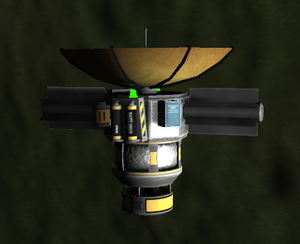Difference between revisions of "Ion-Powered Space Probe"
THEMUNROVER (talk | contribs) m (Added stock craft link box thing at bottom of page) |
m |
||
| (10 intermediate revisions by 8 users not shown) | |||
| Line 2: | Line 2: | ||
[[File:IPSP orbit.png|thumb|The probe in an orbit around [[Kerbin]]]] | [[File:IPSP orbit.png|thumb|The probe in an orbit around [[Kerbin]]]] | ||
| − | The '''Ion-Powered Space Probe''' is a [[Stock craft|stock]] [[probe]] which utilizes the [[ | + | The '''Ion-Powered Space Probe''' is a [[Stock craft|stock]] [[probe]] which utilizes the [[IX-6315 "Dawn" Electric Propulsion System]] ion engine. |
| − | This probe requires a launcher, as the ion engine doesn't | + | This probe requires a launcher, as the ion engine doesn't have a high enough thrust-to-weight ratio (TWR) to leave the ground. The [[Z-MAP Satellite]] launcher is capable of bringing this probe into orbit. |
| − | Two [[PB-NUK Radioisotope Thermoelectric Generator]]s, mounted on opposite sides, are its only electric generators. They are buffered by four [[Z-100 Rechargeable Battery Pack]]s. As the generators aboard don't generate enough electricity and some is needed to run the command module, the ion engine can only run up to | + | Two [[PB-NUK Radioisotope Thermoelectric Generator]]s, mounted on opposite sides, are its only electric generators. They are buffered by four [[Z-100 Rechargeable Battery Pack]]s. As the generators aboard don't generate enough electricity and some is needed to run the command module, the ion engine can only run up to 20% of its maximum thrust. This limits the maximum force applied by the engine to about 400 N or completely dry an acceleration about 0.72 m/s². A possible modification is replacing the PB-NUKs with some solar panels. |
| − | The probe is equipped with | + | The probe is equipped with two [[sensor]]s: A [[2HOT Thermometer]] and a [[Double-C Seismic Accelerometer]]. There is enough room on the probe body for attaching further sensors like the [[GRAVMAX Negative Gravioli Detector]]s. |
| + | |||
| + | == Craft Description == | ||
| + | {{Quote|This small probe may look cute and unimpressive, but once it deploys its long-range antenna, it looks pretty much the same.<br />Its Ion engine is very efficient for a spacecraft this small, so it can go very far indeed, as long as something helps it get into orbit first, of course.|Squad}} | ||
| + | |||
| + | == Capabilities == | ||
| + | |||
| + | The probe has almost 4.5 km/s of delta-V. This is enough to leave Kerbin orbit and travel anywhere in the solar system, provided the operator can be patient with its limited [[TWR]]. On small moons (all of them except for [[Tylo]]) and planets ([[Moho]], barely, and [[Eeloo]]), the probe has enough thrust to land and take off. | ||
{{Stock craft}} | {{Stock craft}} | ||
[[Category:Stock craft]] | [[Category:Stock craft]] | ||
Latest revision as of 20:54, 23 August 2019


The Ion-Powered Space Probe is a stock probe which utilizes the IX-6315 "Dawn" Electric Propulsion System ion engine.
This probe requires a launcher, as the ion engine doesn't have a high enough thrust-to-weight ratio (TWR) to leave the ground. The Z-MAP Satellite launcher is capable of bringing this probe into orbit.
Two PB-NUK Radioisotope Thermoelectric Generators, mounted on opposite sides, are its only electric generators. They are buffered by four Z-100 Rechargeable Battery Packs. As the generators aboard don't generate enough electricity and some is needed to run the command module, the ion engine can only run up to 20% of its maximum thrust. This limits the maximum force applied by the engine to about 400 N or completely dry an acceleration about 0.72 m/s². A possible modification is replacing the PB-NUKs with some solar panels.
The probe is equipped with two sensors: A 2HOT Thermometer and a Double-C Seismic Accelerometer. There is enough room on the probe body for attaching further sensors like the GRAVMAX Negative Gravioli Detectors.
Craft Description
| “ | This small probe may look cute and unimpressive, but once it deploys its long-range antenna, it looks pretty much the same. Its Ion engine is very efficient for a spacecraft this small, so it can go very far indeed, as long as something helps it get into orbit first, of course. — Squad |
” |
Capabilities
The probe has almost 4.5 km/s of delta-V. This is enough to leave Kerbin orbit and travel anywhere in the solar system, provided the operator can be patient with its limited TWR. On small moons (all of them except for Tylo) and planets (Moho, barely, and Eeloo), the probe has enough thrust to land and take off.